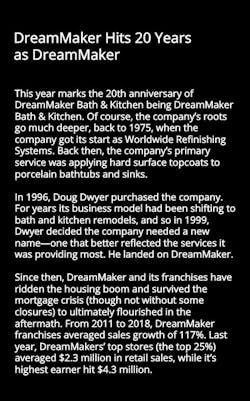The last recession cost the remodeling industry a lot. The businesses it didn’t close, it crippled. And the workers it didn’t displace, it damaged. Three-fourths of business economists predict the country will be in another recession by 2021, and more than half say by 2020, according to a February survey from the National Association for Business Economics. For remodelers, planning ahead for a slowdown can make a big difference.
When the crash hit in 2007, the market was coming off years of strong growth. From 1999 to 2007, the amount homeowners were spending annually on discretionary remodeling projects grew from $58 billion to $108 billion, according to the Harvard’s Joint Center for Housing Studies. That was the economic landscape when remodeling franchise business DreamMaker Bath & Kitchen rebranded in 1999, changing its name from Worldwide Refinishing Systems. This June marks 20 years since that change.
By 2009, annual discretionary remodeling spending had dropped to $81 billion, plummeting even further to $63 billion by 2011.
DreamMaker took a hit in those years, closing several franchises. But unlike many of its competitors, it didn’t go under. The company rebuilt and is now one of the larger design-build remodeling businesses in the country, with 34 franchises averaging about $1.1 million per store.
We spoke with four DreamMaker franchise owners who weathered the recession. These conversations shine a light on how they survived the last slowdown, and what they’re doing to prepare in case the next recession hits.
Build and/or fatten your cash cushion
J.D. Norris has owned a remodeling company since 1990, and his DreamMaker franchise in Aiken, S.C., since 2008. He remembers the recession well.
“First time I really felt the downturn was April 2008,” he says. “I have trouble remembering my own family’s birthdays. But I remember April 2008 vividly.” Norris had a lot to say about how he got through the experience, and what he ultimately learned from it. But his top three takeaways could be summed up in a single breath: “1. Build an emergency fund, 2. Increase the emergency fund, and 3. Have a nice, comfortable emergency fund.” He said some version of this nine times during our talk—because yes, I counted. It never felt overstated—just important.
“You want a minimum of three months of operating costs, but shoot for six. It’s how you’ll keep your business afloat when there isn’t enough revenue coming in to cover overhead”
“You want a minimum of three months of operating costs, but shoot for six,” Norris says. It’s how you’ll keep your business afloat when there isn’t enough revenue coming in to cover overhead.
It was a common thread throughout the four interviews conducted for this story. Lee Willwerth of DreamMaker Ann Arbor, Mich., Nate Coombs of DreamMaker Ogden, Utah, and Curt Trampe of DreamMaker Springfield, Ill., all emphasized the importance of maintaining healthy cash reserves to supplement wages and bills in down times.
Tell your partners what’s up
Bills in down times are a thing. And the reality is you may not be able to pay them.
“We were in the red with vendors, trying to pay them as quickly as we could, but it wasn’t as quickly as we’d have liked,” says Willwerth, who went from software engineer to remodeler when he purchased a DreamMaker franchise in 2004. “The first thing we did was let our vendors know we weren’t going bankrupt.” But he was honest, sending letters to suppliers letting them know that while money was coming in slow, it was still coming, and that the bills would eventually be paid.
“We asked them to work with us,” he says. “And they did. Every single company thanked us for reaching out, because most [remodelers] just went silent and stopped paying altogether.”
And keep your subs happy
When it came to subs, Coombs—an Air Force veteran who started in 2007 as a salesperson and designer at the DreamMaker Ogden franchise he now co-owns—says that having strong working partnerships in place was the key to not losing subcontractor labor to more profitable building jobs. One practice that helped maintain solid relationships was to never haggle.
“Even through the recession we stayed high on our subs’ priority lists,” Coombs says. “When they upped their rates, we didn’t argue. And we always pay them on time.” He says that in particular the consistent, timely payments have been crucial to building sustained value.
Protect marketing, but market smarter
Another suggestion that kept coming up, in a “this-is-sort-of-obvious-but-needs-to-be-stated” way, was that companies should maintain a marketing budget in down times.
“We never stopped putting money into marketing and advertising during the downturn,” says Coombs. “We wanted to keep our name in front of the people who could still afford it.”
Trampe, who’s been in the remodeling field for 30 years and purchased his DreamMaker franchise in 2006, echoed the sentiment, saying, “If the recession taught me anything, it’s that you need marketing more when things are slow.”
Of course, no budget item is safe when circumstances are as dire as they were by 2009, and so knowing where and how to market when the fiscal ax is drawing nigh is crucial.
For Coombs, trimming marketing meant tightening the scope to only local channels, which for him included advertising in local print publications (always in the front) and using ground-level tactics, such as yard signs and delivering marketing packages door-to-door in neighborhoods where they were already doing a project. One thing he did cut was his TV budget—something every interviewee mentioned.
Trampe relied on past clients to better understand what was effective. “We did a focus group,” he says. “Brought 15 to 20 clients to a restaurant and over drinks and hors d’oeuvres, with a notebook in hand, I probed them about how they consume information and media.” Not only did it let him know what marketing channels had been most effective, but it served as a positive reminder that certain efforts were paying off.
“I was beat down in the downturn, and it was uplifting to hear positive feedback from clients” Trampe says. “It was a needed psychological boost.”
From 2007 to 2009, DreamMaker saw a 32% drop in Average Unit Store Sales. Between 2011 and 2018, it saw a 117% increase.
Don’t Sleep on Small Jobs
One important thing Willwerth learned during the recession is that you can’t be seen as the company who’s too good for small jobs. “We don’t restrict homeowners by dollar value on the types of materials they want to buy,” he says, explaining that while the level of service remains constant, the profitability of a job doesn’t have to. It’s because the more profitable jobs tend to drop off in down times. “From 2008 to 2010, we only did one kitchen remodel.” Jobs were still there, but the size of those jobs shifted down.
From 2007 to 2011, the amount spent annually on kitchen remodels dropped from $31 billion to $20 billion, while the spending on bathrooms only dropped from $18 billion to $13 billion. Similarly, while annual discretionary spending went down a staggering $45 billion in those four years, replacement project spending—a $108 billion market in 2007—had already recovered to $101 billion by 2011.
“We maintain a reputation that we’re not exclusive to big projects,” Willwerth says. “When the big jobs leave, I want to be able to pivot and go after the work that’s still out there.” That means taking small jobs now that may be less profitable, and reminding homeowners in your marketing that more basic remodeling services are available.
The ability to pivot job types is similar to how all remodelers we talked with want their business systems to operate. “If the economy contracts in any significant way, we want to be able to quickly adjust,” says Willwerth. He urges that remodelers abandon cumbersome paper processes for more tech-based systems. “It improves your ability to grow as much as it does your ability to downsize,” he says. “It also allows you to quickly downsize office space, or move to a remote system if you need to cut expenses, like rent, quick.”
Sliding scalability: Responsibilities
The other side of that equation is staff and responsibilities. No one wants to layoff staff, but at some point, it may become the difference between staying viable and shuttering.
Trampe says that remodelers should have a written plan in place for where responsibilities go in the event of downsizing. “Every remodeler should have a workflow chart, explaining what positions handle what responsibilities,” he says. “When you downsize, you don’t simply do away with positions and let the responsibilities float. You need to know who will cover what in the event a person leaves.”
Trampe suggests remodelers create a guide from previous growth to better understand what volume requires what level of help, so you know better when it’s time to downsize. “Setting volume benchmarks is key.”
Sliding scalability: Indicators
Knowing your numbers is critical to understanding your market health. “Material cost, labor cost, trade cost, gross profit margin, overhead, leads, close ratios—those are all numbers you need to be tracking,” Trampe says. “Remodelers need a gauge for what ‘normal’ means for their business.”
Every year, Trampe creates three budgets—one “lean and mean,” one “average,” and one “gangbusters”—that give him a predetermined business path for each possible market scenario. “They also serve as an early indicator for where the year and market is heading.”
Beyond numbers, Willwerth uses his client surveys as further indicators to see where the market is heading. “We keep track of everything in the job pipeline, so if a homeowner wants to do a project but never ends up signing, we keep track of that fact as well as why the client didn’t end up wanting to sign,” he says. “Consumer confidence is a big indicator of market health. Understanding why jobs are dropping off is important for understanding that confidence.” He says that he doesn’t want to get caught “flat-footed” the way he was in 2008.
Respect your staff enough to communicate
Finally, J.D. Norris puts it best when he says, “Treat your staff as important and show them appreciation by communicating the realities of the struggles your company is facing. Don’t keep them in the dark.”
He, as well as Willwerth, Trampe, and Coombs, all run their businesses with open books, conducting quarterly reviews of the business’s current profit and loss report, and providing analysis. Willwerth explains that business owners should refrain from “freaking employees out,” but says that ultimately having hard conversations early is better than having them sprung on you.
About the Author

James F. McClister
James McClister is managing editor for Professional Remodeler.


